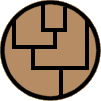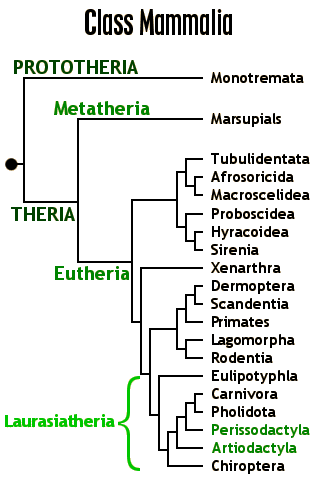
Within the mammals, there are two extant subclasses: the Prototheria, containing only three modern species of egg-laying monotremes (Order Monotremata); and the Theria, or viviparous mammals (those which give birth to live young). The Theria are subdivided further into the marsupials (infraclass Metatheria), and the eutherians or placental mammals (Eutheria). Ungulates - and most of the other 4,500+ mammal species - are eutherians, mammals which nourish their young inside the mother's body using a chorioallantoic placenta (in eutherians, the placenta acts as an endocrine organ during pregnancy). The extended time which young can develop inside their mothers gives infant eutherians a head-start in life, and is responsible for the ability of many ungulates to run only hours after birth.
The two ungulate orders (Perissodactyla and Artiodactyla) do not isolate from the rest of the mammals together, and thus they do not form a distinct taxonomic group. As we saw in What is an Ungulate?, our understanding of these relationships is rather recent, and is still making its way through the scientific literature. Because the true ungulates no longer stand alone, but are instead nested within the infraclass Eutheria (and the superorder Laurasiatheria), each order must be examined individually.
The easiest way to distinguish the two types of ungulates is to look at their feet (and hooves): Perissodactyls (generally) have an odd number of toes on each foot, while "artiodactyls" (the ungulates within Artiodactyla) usually possess an even number of toes on each foot. Despite the even-odd differentiation, there are exceptions to the rule: for instance, both tapirs (Perissodactyla: Tapiridae) and some peccaries (Artiodactyla: Tayassuidae) have four toes (and hooves) on their front feet, and three on the rear. How is this difference accounted for? It is not officially the NUMBER of toes, but their ARRANGEMENT, that differentiates the two orders. Perissodactyls have a mesaxonic foot structure, where the plane of symmetry of the foot passes through the third digit (this digit also bears most of the animal's weight). In artiodactyls, the third AND fourth digit are the principal weight bearers (i.e., the axis of the foot passes BETWEEN the two toes), with the result that their foot structure is paraxonic.
Perissodactyla AND Artiodactyla
Or keep exploring this site:
| What
is an UNGULATE? |
Ungulates
of the World |
